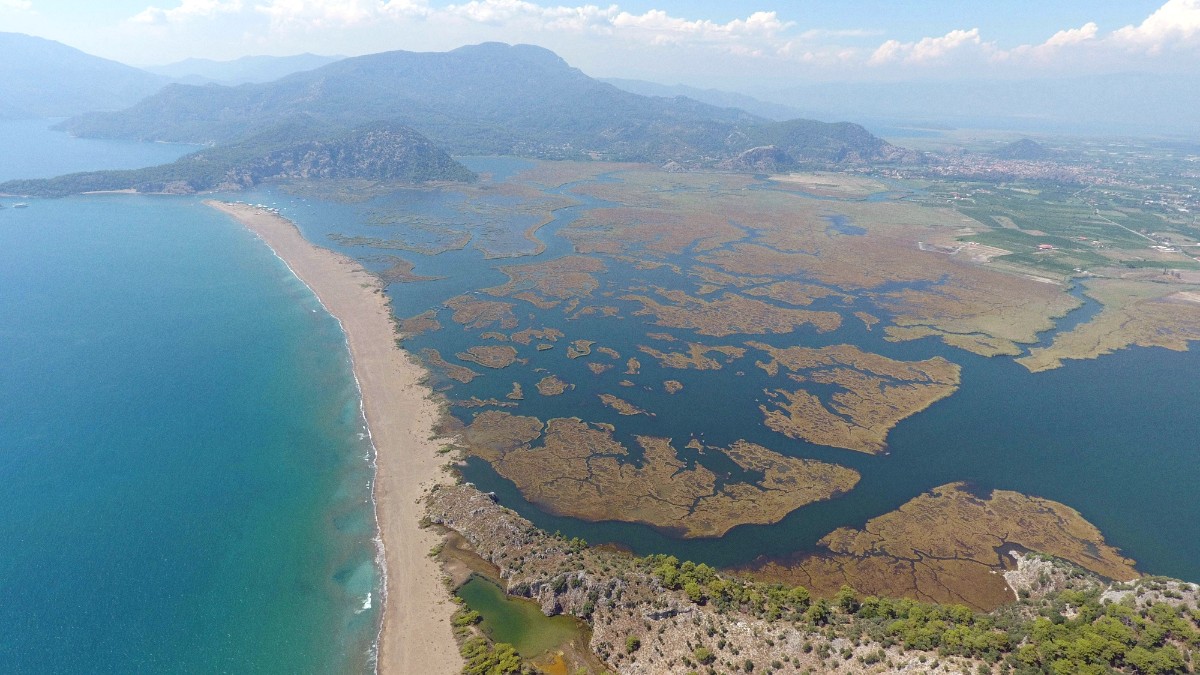
Mediterranean Coast, Turkey
The journey from Dalaman International Airport (DLM) to Dalyan takes approximately 28 kilometers (17 miles). This proximity makes travel to the town straightforward for international visitors. Despite being near the coast, Dalyan is not directly on the beachfront. Its unique connection to the sea occurs via the winding Dalyan River, which directly leads to the famed Iztuzu Beach. This river access means boat trips are a main and delightful mode of transport for reaching the beach and other riverine attractions. This geographic setup maintains Dalyan's tranquil inland feel. Direct, convenient access to the coast is present.
The landscape around Dalyan is a visual treat. A fertile delta, formed by the river's slow journey, dominates the area. This delta is a rich ecosystem, characterized by extensive reed beds that home diverse wildlife. Travelers often explore these reeds by boat, enjoying the quiet beauty and the chance to spot various bird species. Beyond the delta, pine-clad hills rise gently, a green backdrop to the town and river. These hills invite hiking and exploration, bringing panoramic views of the delta, the lake, and the distant sea.
A defining geological feature of the region is the presence of limestone cliffs. These dramatic rock faces line sections of the river, and add a striking element to the scenery. They are also the canvas for Dalyan's most famous historical landmarks: the Lycian Rock Tombs. The interplay of water, lush delta, green hills, and ancient stone cliffs forms a landscape that is both picturesque and ecologically valuable. This distinctive environment, a blend of river, lake, and sea, along with its unique geological formations, Dalyan is a standout destination on the Turkish coast.
Dalyan’s historical story intertwines with the ancient Carian city of Kaunos. This important site sits directly across the Dalyan River from the modern town, a constant reminder of the area’s deep past. Kaunos was once a bustling port city, a hub for trade and culture in ancient times. Its origins trace back to at least the 10th century BCE; a long and active history is present. The city flourished for centuries, witnessing the rise and fall of various empires, from Carian and Lycian to Persian, Hellenistic, Roman, and Byzantine influences. Each period left its mark on the city's architecture and way of life.
The decline of Kaunos presents a historical lesson in geography. Over time, the very harbor that brought it prosperity began to silt up. The accumulation of river sediment eventually rendered the port unusable, diminishing Kaunos's strategic importance and leading to its gradual abandonment. Today, the ruins are a testament to this process, natural changes reshaping human civilizations.
Early port city and regional power. 10th century BCE onwards
Royal burial sites, architectural marvels. 4th century BCE
Public life, entertainment, trade, Roman influence. 3rd century BCE - 3rd century CE
Christian era, city's later life. 4th - 7th century CE
The most visually striking historical features in Dalyan are the Lycian rock tombs. These magnificent burial chambers are not structures built on the ground, but rather intricate facades carved directly into the sheer limestone cliffs above the Dalyan River. Dating mainly from the 4th century BCE, these tombs belong to the Lycian civilization, an unique culture that inhabited this region of Anatolia. Scholars believe these impressive monuments functioned as resting places for the kings and wealthy nobles of Kaunos. The decision to carve them high into the cliffs likely showed a belief in a higher status for the deceased, placing them closer to the heavens.
The artistry of the Lycian tombs is exceptional. Their facades often mimic the architectural styles of contemporary wooden temples or houses, complete with columns, pediments, and intricate decorative elements. This design grants a glimpse into the sophisticated architectural capabilities of the Lycians. Visitors gaze upon them from the river below, a powerful visual connection to a distant past. The tombs also hint at a complex belief system surrounding death and the afterlife, reflecting the cultural values of the people who created them.
Beyond the tombs, the ruins of Kaunos hold many other historical treasures. Explore the ancient theatre, a grand structure carved into the hillside. It once hosted dramatic performances and public gatherings, seating thousands of spectators. From its upper tiers, panoramic views of the surrounding landscape, including the Dalyan River and delta, are visible. This setting showcases the careful planning of ancient city builders, who often integrated their structures with the natural environment.
Discover the remnants of Roman baths, an integral part of Roman daily life for hygiene, socialization, and relaxation. The presence of such extensive bath complexes points to the city's prosperity and its adherence to Roman customs during that period. A large basilica, likely a public meeting hall or a court of law, also points to the civic organization of Kaunos. Furthermore, the acropolis, perched atop the highest point of the city, functioned as a defensive stronghold and held important religious structures. Each stone whispers stories of trade, daily routines, religious practices, and political shifts. The deep historical layers of Kaunos makes Dalyan a captivating destination for anyone interested in ancient civilizations and their enduring legacies.
Wear sturdy, comfortable shoes when you explore the ancient city of Kaunos. The terrain is uneven, and you will walk on ancient stones and dusty paths.